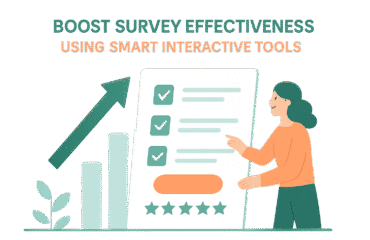
Want a More Engaging and Effective Survey? Discover Our Smart Tools!
- Utilizing interactive methodologies can enhance survey engagement and effectiveness.
- Max-Diff exercises uncover true preferences by forcing trade-offs among options.
- Card Sort exercises help understand consumer perceptions and priorities.
- Digital tools like Drag & Drop exercises and online simulators facilitate richer data collection.
- Combining various methodologies ensures comprehensive insights tailored to the Syrian context.
Table of Contents
The Power of Interactive Survey Design
In Syria, as globally, the way we ask questions and present information significantly impacts how respondents engage with a survey. Simply put, a more engaging survey is often a more effective one. This engagement is not just about making the process fun; it’s about designing instruments that naturally elicit more thoughtful and accurate responses. At Insight Syria, we harness a suite of smart tools to achieve this, moving beyond basic multiple-choice questions to create dynamic research experiences.
One of our most powerful techniques for understanding nuanced preferences is the Max-Diff Exercise, also known as the Best-Worst Scaling method. This approach is particularly adept at uncovering what truly matters most to individuals when presented with a range of attributes or options. Instead of asking respondents to rate each item individually on a scale, they are presented with subsets of items and asked to identify the “best” (most preferred) and “worst” (least preferred) within that subset.
Imagine trying to understand what Syrian consumers prioritize in a new product – perhaps a type of food, a technological device, or a service. A traditional survey might ask them to rate various features on a scale of 1 to 5. This can be cumbersome and lead to respondents giving similar scores across many features. With a Max-Diff exercise, we might present them with a subset of features like “Affordable Price,” “High Quality Ingredients,” “Innovative Design,” and “Brand Reputation.” They would then be asked to select the most and least important among these. The power lies in forcing a trade-off, revealing genuine priorities.
This methodology is invaluable for our clients in understanding consumer preferences, identifying key drivers of satisfaction, and optimizing product or service offerings within the Syrian market. Our extensive experience in deploying Max-Diff exercises has consistently shown its ability to uncover subtle but critical distinctions that might otherwise be missed.
Complementing the Max-Diff exercise, we also utilize Card Sort exercises. This qualitative research method is incredibly effective for understanding how individuals categorize and organize information. Participants are given a set of “cards,” each representing a concept, product feature, or service. They are then asked to group these cards in a way that makes sense to them, often with the instruction to create their own categories.
In the Syrian context, card sorting can be instrumental in understanding how consumers perceive brands, how citizens organize their priorities when thinking about public services, or how different media messages are understood and categorized. For example, when working with a government ministry aiming to improve public communication, a card sort could reveal how citizens naturally group different types of government initiatives or how they associate specific keywords with particular services.
This provides a direct, unprompted view into their mental models, which is crucial for designing effective communication strategies and information architecture. Our team’s experience in facilitating and analyzing card sorts allows us to translate these groupings into actionable insights for branding, service design, and policy development.
Enhancing Data Collection with Digital Tools
Beyond these specialized preference and categorization techniques, Insight Syria also embraces digital tools to make surveys more dynamic and capture real-time behavior. The Drag & Drop exercise is a prime example. This interactive feature allows respondents to visually manipulate elements on a screen, typically by dragging items into designated boxes or categories.
This goes beyond simple selection. It allows for a more intuitive and engaging way to gather information. For instance, if we are conducting research on media consumption habits, a drag-and-drop exercise could involve respondents dragging different types of media (e.g., TV news, social media, radio, online articles) into categories representing “primary source of information” or “most trusted source.” The act of physically moving the items can lead to more considered responses and a more enjoyable user experience, reducing survey abandonment rates.
Our experience shows that this visual and interactive approach is particularly effective with younger demographics and can provide richer data on preferences and priorities.
In today’s data-rich environment, Media Monitoring is an indispensable tool for understanding public discourse and sentiment. At Insight Syria, we employ sophisticated media monitoring techniques that go beyond simply tracking mentions of a brand or topic. We analyze the sentiment, context, and reach of conversations across traditional media, social media, and online platforms within Syria.
This allows us to gauge public reaction to policies, track emerging trends, and understand the narrative surrounding key issues. For government bodies and organizations operating in Syria, understanding the public conversation is critical for informed decision-making. Are people discussing a new infrastructure project positively or negatively? What are the key concerns being raised on social media regarding economic policies?
Our experience in media monitoring helps clients stay ahead of the curve, identify potential reputational risks or opportunities, and tailor their communications for maximum impact. This also directly informs our survey design, allowing us to ask more relevant and timely questions based on current public discourse.
Furthermore, we leverage advanced digital simulations to mimic real-world decision-making scenarios. The Shopping Cart and Online Simulators are powerful tools for understanding consumer behavior in a more realistic context. Instead of asking hypothetical questions about purchasing decisions, respondents are placed in a virtual environment where they can “shop” for products or services, add them to a virtual cart, and make purchasing decisions.
This allows us to observe actual choices, understand price sensitivity, and identify factors that influence the path to purchase. For example, we could simulate an online grocery store where respondents can choose items, compare prices, and make selections. This provides invaluable data on product appeal, brand loyalty, and the impact of promotions.
Our experience in deploying these simulators for clients in Syria has provided deep insights into consumer purchasing patterns, helping businesses optimize their online strategies and product assortments.
The Synergy of Methodologies and Expertise
At Insight Syria, we don’t just offer these tools in isolation. Our strength lies in our ability to integrate these diverse methodologies and experience into comprehensive research strategies. We understand that the Syrian context is unique, with its own cultural nuances, economic realities, and communication channels.
Our team of experienced researchers and data scientists possesses deep local knowledge, which we combine with global best practices in survey design and data analysis.
For a government organization looking to understand public satisfaction with a new public health initiative, we might combine media monitoring to gauge initial public reaction, followed by a Max-Diff exercise to understand which aspects of the initiative are most valued, and a drag-and-drop exercise to assess how citizens categorize different health-related behaviors. For a commercial entity looking to launch a new product, we could use shopping cart simulators to test pricing and product configurations, complemented by card sorting to understand how consumers group product features and benefits.
Our commitment to quality extends to ensuring that our surveys are not only engaging but also accessible and inclusive. We consider factors such as literacy levels, access to technology, and cultural sensitivities when designing our research instruments. This ensures that our data is representative of the Syrian population and provides a true reflection of their opinions and behaviors.
Practical Tips for More Effective Surveys
For any organization or individual looking to conduct more effective surveys, whether they are working with us or looking to improve their internal research efforts, here are some practical tips:
- Clearly Define Your Objectives: Before designing any survey, be absolutely clear about what you want to achieve. What specific questions do you need answered? What decisions will this data inform? Clarity of objective will guide your choice of methodology and question design.
- Know Your Audience: Understand who you are surveying. Consider their demographics, their level of familiarity with the topic, their cultural background, and their potential access to technology. This understanding is crucial for selecting the right tools and language.
- Prioritize Engagement: Think about how to make the survey experience as engaging as possible. Use interactive elements like drag-and-drop questions where appropriate. Break down complex questions and avoid survey fatigue by keeping the survey concise.
- Embrace Variety: Don’t rely on a single question format. Mix question types to keep respondents interested and to capture different facets of their opinions. Utilize methods like Max-Diff exercises for nuanced preference measurement and card sorts for understanding categorization.
- Leverage Technology Wisely: Utilize digital tools like online simulators and media monitoring to gather richer, more contextualized data. Ensure that the technology is user-friendly and accessible to your target audience.
- Test and Iterate: Before launching your survey widely, conduct pilot tests. Get feedback from a small group similar to your target audience to identify any confusing questions, technical glitches, or areas where engagement might be lacking. Refine your survey based on this feedback.
- Focus on Actionability: The ultimate goal of any survey is to generate actionable insights. Ensure that the data you collect can be translated into concrete strategies and decisions. This means designing questions that provide clear, interpretable results.
At Insight Syria, our experience has taught us that the most effective surveys are those that are thoughtfully designed, technologically advanced, and deeply considerate of the audience. By employing a diverse range of interactive and smart tools, we empower our clients – including governments and organizations focused on social, political, and market research – with the robust data they need to navigate the complexities of the Syrian landscape and achieve their objectives. We are more than just a data collection agency; we are your strategic partner in understanding Syria.
FAQ
What are Max-Diff exercises and why are they useful?
Max-Diff exercises help to uncover the most important preferences of respondents by forcing them to make trade-offs among different options, revealing genuine priorities.
How can digital tools enhance survey effectiveness?
Digital tools like Drag & Drop exercises create a more engaging user experience, leading to better response quality and lower survey abandonment rates.
Why is media monitoring important in survey design?
Media monitoring provides insights into current public discourse and sentiment, helping to formulate relevant and timely survey questions.
How can organizations ensure their surveys are accessible?
By considering factors such as literacy levels, access to technology, and cultural sensitivities when designing surveys, organizations can ensure they collect data that is representative of the population.
What are the benefits of using card sorting in surveys?
Card sorting helps understand how respondents categorize information, providing insights into consumer perceptions and aiding in effective communication design.



